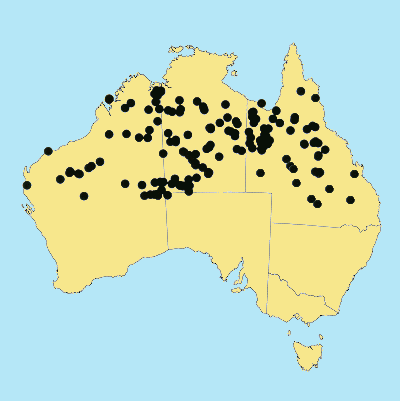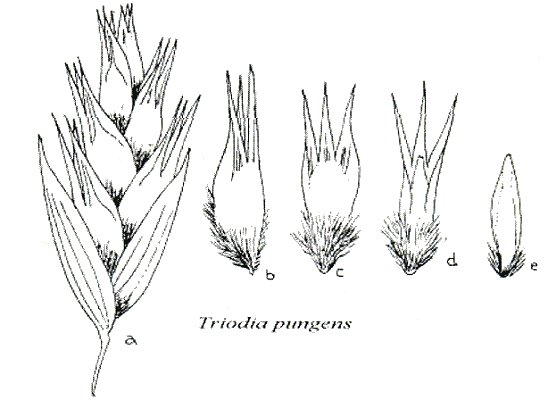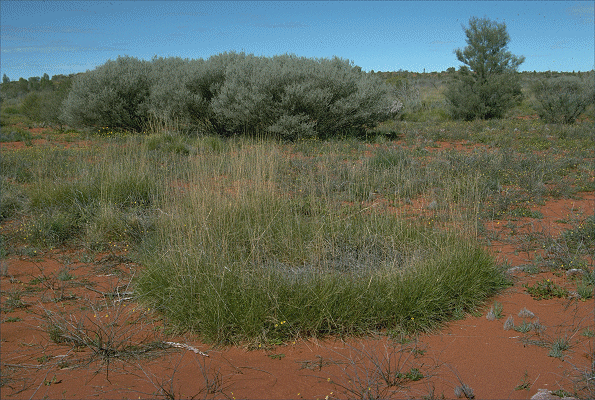Triodia pungens R. Br. Prodr. 182
(1810). Classification. (GPWG 2001) :
Subfamily
Chloridoideae. Triodeae.
Type of Basionym or
Protologue Information: Northern Territory: Darwin and Gulf District;
Carpentaria, North Coast, R. Brown [6257] (HT: BM; IT: E, K, PERTH
(photos), MEL, NSW (2 sheets)).
Key references
(books and floras): [1810]. R.Brown, Prodromus (182), [1878]
G.Bentham, Flora Australiensis 7 (606), [1952] C.A.Gardner, Flora of
Western Australia 1 Gramineae (74), [1981] M.Lazarides in J.Jessop
(ed)., Flora of Central Australia (445), [2002] D.Sharp & B.K.Simon,
AusGrass, Grasses of Australia, [2006] J.Jessop, G.R.M.Dashorst,
F.M.James, Grasses of South Australia (416).
Illustrations:
[1952] C.A.Gardner, Flora of Western Australia 1 Gramineae (65,
Pl. 17), [2006] J.Jessop, G.R.M.Dashorst, F.M.James, Grasses of South
Australia (416, fig. 347).
Habit.
Perennial. Stolons present. Culms 15–230 cm tall. Leaf-sheath auricles absent.
Ligule a fringe of hairs. Leaf-blades flexuous or tortuous, aciculate, flat or
conduplicate, 34 cm long, 0.8–1.2 mm wide.
Inflorescence.
Inflorescence compound, a panicle. Panicle linear or pyramidal, 14–27(–37) cm
long, 1–2.5(–3.5) cm wide, contracted about primary branches.
Spikelets.
Spikelets pedicelled. Fertile spikelets many flowered, with at least 2 fertile
florets (5–6), comprising 5–6 fertile floret(s), with diminished florets at the
apex, lanceolate, laterally compressed or terete, 7–12(–16) mm long.
Glumes.
Glumes similar, thinner than fertile lemma. Lower glume oblong, scarious or
cartilaginous or indurate, without keels, 3–5(–7) -nerved. Lower glume surface
glabrous or indumented. Lower glume apex muticous or mucronate. Upper glume
oblong, 3–10 mm long, scarious or cartilaginous or indurate, without keels,
3–5(–7) -nerved. Upper glume surface glabrous or indumented. Upper glume apex
entire, muticous or mucronate.
Florets.
Fertile lemma 5–8 mm long, without keel or keeled, 9(–12) -nerved. Lemma
surface glabrous or indumented. Lemma apex entire or lobed, muticous. Anthers
3.
Continental
Distribution: Australasia.
Australian
Distribution: Western Australia, Northern Territory, South Australia,
Queensland.
Western Australia:
Gardner, Fitzgerald, Hall, Dampier. Canning, Carnegie, Giles, Fortescue,
Ashburton, Carnarvon. Irwin, Avon. Northern Territory: Darwin &
Gulf, Victoria River, Barkly Tableland, Central Australia North, Central
Australia South. South Australia: North-western. Queensland:
Burke, Cook, Gregory North, Leichhardt, Mitchell, North Kennedy, South Kennedy,
Warrego, Port Curtis.
Flora
of Australia Notes. Distinguished by its linear panicles; usually closely
flowered spikelets; sparsely hairy usually deeply lobed lemmas; resinous
foliage.
Burke,
Cook, Leichhardt, Mitchell, North and S Kennedy, and Gregory North Districts of
Qld, also N.T., W.A. and far NW S.A. On a wide range of deep to skeletal, rocky
and gravelly soils of light to heavy texture, including sands, podsols, loams,
red earths, cracking clays and alluvium, in association with limestone,
laterite, quartzite, sandstone, granite, schists, shales and slates; habitats
include plains, dunes, swales, sandhills, hillslopes, ridges, outcrops, scarps,
mesas, gorge valleys, stony rises, floodout flats, creek banks and levees, the
margins of rockholes, salt lakes, salt pans, and the sandy banks of floodout
channels; town streets; flowers all seasons.




